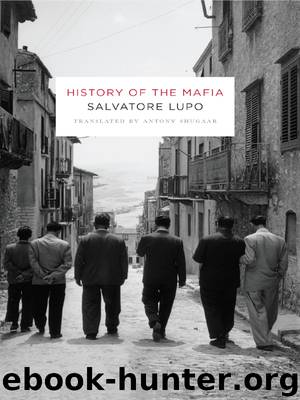History of the Mafia by Salvatore Lupo

Author:Salvatore Lupo
Language: eng
Format: epub
Tags: History/General
Publisher: Columbia University Press
Published: 2012-01-03T16:00:00+00:00
OLD/NEW MAFIA
Cammarata, 1891. Luigi Varsalona, son of a former member of the gang of Don Peppino who had died in prison, quarreled with his accomplices over the shares of the loot from a theft from the prince of Mirto and was killed. The trial of the killers ended with a mild sentence, in part owing to a witness for the defendants. Less than a year later, that witness was in turn killed in an ambush set for him by the brother of the dead man, Francesco Paolo Varsalona; immediately afterward, Francesco Paolo Varsalona fled and went into hiding.69
S. Mauro Castelverde, 1894. The peasant Mariano Farinella was killed by several members of the Glorioso clan whom he had accused of stealing a cow. The young son of the victim, Vincenzo, witnessed the crime and after a lengthy hesitation, “broke the customary silence” and turned to the authorities. The trial, however, ended in acquittal, followed by the ineluctable elimination of the “spy” (1899). A few months later, during a nighttime attack on a farm, three of the alleged killers of the Farinellas were murdered, according to the investigators, by Antonio Farinella, son and brother, respectively, of the two dead men. Two other Gloriosos then escaped to America, but when they returned to their village fourteen years later, they found the vendetta of Farinella and his four brothers awaiting them.70
Both of these cases involve a classic sequence out of the saga of brigandage: the murdered relative, justice denied, feud, and vendetta. The correspondence between legend and reality ends there, however. Farinella turned into a typical figure of the Alta Maffia, leaseholder, mayor, but also accomplice and abettor of Melchiorre Candino, a leading figure in local banditry.71 Varsalona remained a fugitive from the law for more than ten years, personifying what Detective Alongi called the turning point of brigandage: the abandonment of the old technique of kidnapping and the institution in the hinterland of a racket strategy borrowed from the coastal Mafia, with the creation of a network composed of bandits, campieri, or private guards of farmland, peasants, and landowners, with the levying of “a new type of land-based surtax that allowed landowners and gabellotti to move freely through the countryside … confident that they could buy back whatever was stolen from them by criminals not affiliated with the gang, who were inexorably suppressed.”72
In the Varsalona and Farinella cases, then, there emerges a close similarity between the roles of mafioso and brigand, with the prime difference to be found in the warrant for the arrest of each. Candino lived in hiding for well over three decades, and according to public opinion his presence was tolerated “for services rendered to the police,”73 feeding himself “with checks from the feudal landowners.” His time on the run would come to an end in 1922 with the surreal touch of a public manifestation of approval from the notables of Gangi, concerned about preserving order in the countryside after the “brigand” retired to a private existence.74 We are quite
Download
This site does not store any files on its server. We only index and link to content provided by other sites. Please contact the content providers to delete copyright contents if any and email us, we'll remove relevant links or contents immediately.
The Borden Murders by Sarah Miller(4031)
The Secret Barrister by The Secret Barrister(3430)
Coroner's Journal by Louis Cataldie(2364)
Police Exams Prep 2018-2019 by Kaplan Test Prep(2364)
The Splendid and the Vile by Erik Larson(2233)
Terrorist Cop by Mordecai Dzikansky & ROBERT SLATER(1969)
My Dark Places by James Ellroy(1807)
A Colony in a Nation by Chris Hayes(1800)
Black Klansman by Ron Stallworth(1708)
The Art of Flight by unknow(1697)
A Life of Crime by Harry Ognall(1598)
Objection! by Nancy Grace(1572)
The New Jim Crow by Michelle Alexander(1552)
Whoever Fights Monsters by Robert K. Ressler(1540)
Anatomy of Injustice by Raymond Bonner(1533)
Invisible Women by Caroline Criado Perez;(1521)
Obsession (The Volkov Mafia Series Book 1) by S.E Foster(1499)
American Prison by Shane Bauer(1483)
A is for Arsenic: The Poisons of Agatha Christie (Bloomsbury Sigma) by Kathryn Harkup(1458)
